When it comes to hiking with our canine companions, responsible pet ownership extends to the proper disposal of their waste. Cleaning up after dogs on trails is not just a matter of courtesy; it is crucial for preserving the natural environment and ensuring the well-being of all trail users. In this article, I will explore effective ways to dispose of dog poop while hiking, promoting responsible behavior and minimizing our impact on the trails.
Key Takeaways:
- Dispose of dog poop while hiking to maintain a clean and healthy environment for all trail users.
- Improper disposal of dog waste can have negative consequences on the environment, including the spread of diseases and pollution of water sources.
- Consider using stink-free containers, training your dog to carry its waste, or responsibly burying the poop as effective disposal methods.
- Composting toilets and biodegradable dog poop bags are other environmentally friendly options for waste management while hiking.
- Responsible pet ownership includes following local regulations and guidelines for waste disposal and practicing leave no trace hiking.
The Consequences of Improper Disposal
Improper disposal of dog poop while hiking can have serious consequences for the environment and public health. When dog waste is left on the trail, it can spread diseases, contaminate soil, and pollute water sources. The bacteria and parasites present in dog waste can cause harm to other wildlife and even humans. You should be aware of these consequences and take responsible actions to avoid them.
One of the main issues with improper disposal is the spread of diseases. Dog waste contains harmful bacteria such as E. coli and salmonella, which can cause gastrointestinal illnesses in humans and other animals. These bacteria can persist in the soil for extended periods, posing a risk to both wildlife and people who come into contact with contaminated areas. Additionally, the nutrients in dog waste, particularly if dogs are fed a commercial diet, can contribute to the growth of harmful algae in water bodies, leading to imbalances in aquatic ecosystems.
Proper disposal of dog poop is crucial to maintain the integrity of hiking trails and minimize environmental impact. By following responsible waste management practices, such as using biodegradable bags, burying waste in designated areas, or utilizing composting toilets, hikers can help preserve the natural beauty of the trails and ensure a safe and healthy environment for all.
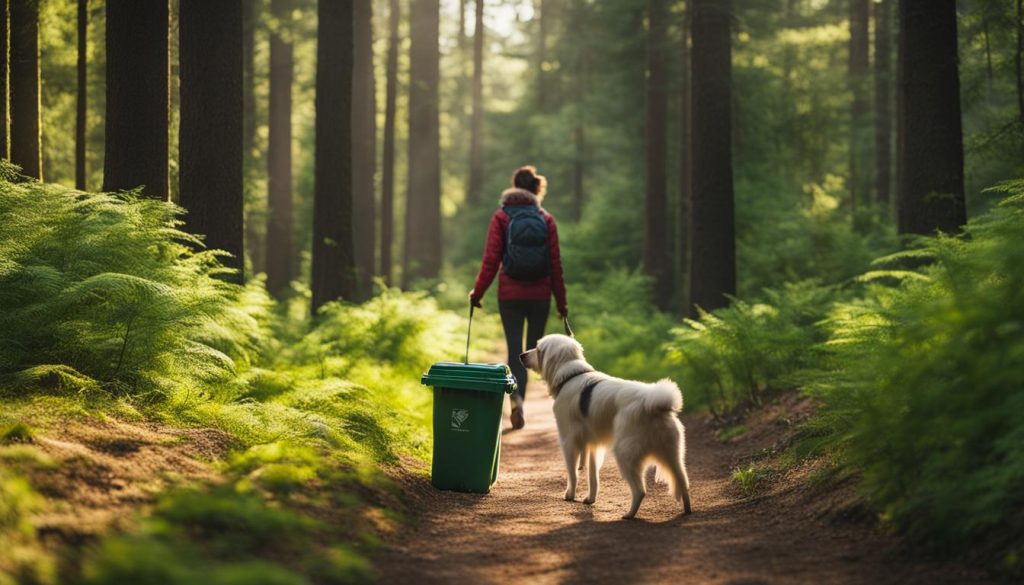
Table: Consequences of Improper Dog Poop Disposal
| Consequence | Description |
|---|---|
| Spread of Diseases | Dog waste contains bacteria and parasites that can cause illnesses in humans and wildlife. |
| Contamination of Soil | The bacteria and nutrients in dog waste can harm soil quality and affect plant growth. |
| Pollution of Water Sources | When dog waste enters water bodies, it can contribute to water pollution and harmful algae blooms. |
| Impact on Wildlife | Dog waste can attract wildlife, leading to disruption of natural behaviors and potential conflicts. |
Use a Stink-Free Container
When it comes to disposing of dog poop while hiking, using a stink-free container is an effective and convenient option. Products like the PooVault or Turdlebag are specifically designed to securely hold bagged poop and minimize odor. These containers can be easily attached to your backpack or leash, allowing you to carry the waste without any discomfort or unpleasant smells. They are particularly useful for shorter hikes or day trips when you don’t want to carry a full bag of dog waste for an extended period.
By using a stink-free container, you can ensure that both you and the surrounding hikers can enjoy a clean and odor-free hiking experience. These containers are designed to seal in the smell, preventing any unpleasant odors from escaping. Additionally, they are made from durable materials that are resistant to leaks, providing a reliable option for carrying dog waste on the trail.
Another alternative to dedicated stink-free containers is using a Nalgene bottle to store bagged dog waste. This option is suitable for longer hikes or multi-day trips when you need to carry several days’ worth of waste. However, it is essential to label the bottle clearly to avoid any accidental consumption or confusion. while using a stink-free container is a convenient solution, properly disposing of the waste is of utmost importance to maintain the cleanliness and integrity of the trails.
Table: Pros and Cons of Using a Stink-Free Container
| Pros | Cons |
|---|---|
| Minimizes odor | Requires carrying additional weight |
| Securely holds bagged poop | May be cumbersome to attach to a backpack or leash |
| Durable and leak-resistant | Not suitable for long hikes without access to disposal facilities |
| Easy to clean and maintain | Requires proper labeling to avoid confusion |
Using a stink-free container is a practical and responsible way to dispose of dog poop while hiking. Whether you opt for a dedicated container or repurpose a Nalgene bottle, these solutions help to keep the trails clean and odor-free. Try to always adhere to local regulations and guidelines regarding waste disposal and choose environmentally friendly dog waste bags for a more sustainable hiking experience.
Hiking with Dogs: Make Your Dog Carry It
When embarking on a hiking adventure with your furry companion, responsible pet ownership includes proper dog waste disposal. While carrying your dog’s waste may seem like a burden, training your dog to carry their own waste can free up your hands and minimize your impact on the environment. By utilizing a pack, your dog can take on the responsibility of carrying a couple of days’ worth of waste, reducing the need for you to carry it yourself.
To ensure a hygienic approach, double bag the waste before placing it in your dog’s pack. This will prevent any leakage or odor. Keep in mind that this option works best for dogs that are accustomed to wearing a backpack while hiking and can handle the weight capacity of the pack. Always consider your dog’s comfort and well-being before implementing this method.
In addition to reducing your load, having your dog carry their waste promotes responsible pet ownership and demonstrates a commitment to leaving no trace on the trails. You should remember that while your dog can carry their waste, it is your responsibility to properly dispose of it when reaching a designated waste receptacle or composting toilet along the trail.
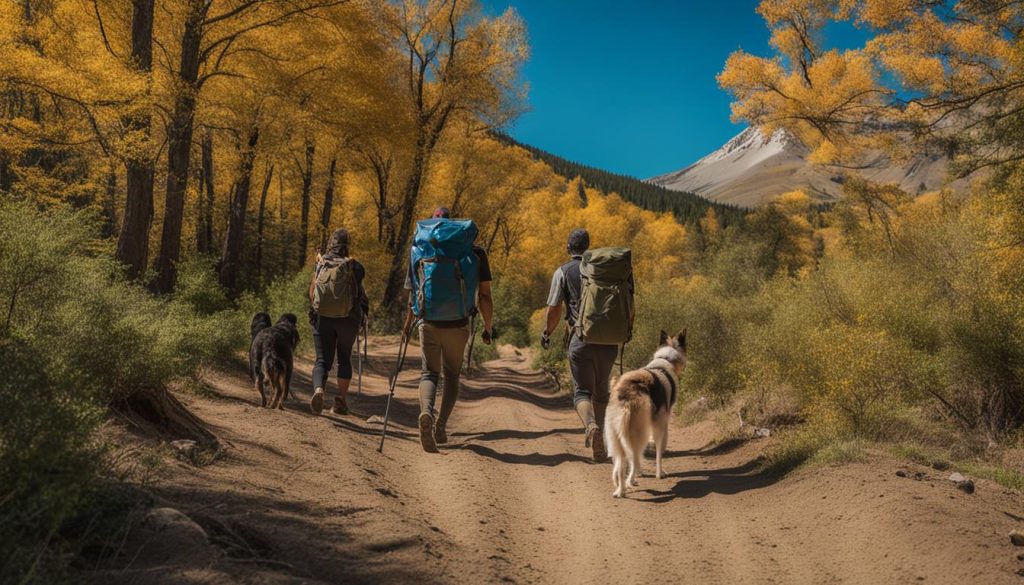
Table: Pros and Cons of Making Your Dog Carry Their Waste
| Pros | Cons |
|---|---|
| Reduces the burden on the hiker | Not suitable for all dogs |
| Promotes responsible pet ownership | Requires training and acclimation for dogs |
| Keeps your hands free | May limit your dog’s mobility |
| Minimizes environmental impact | Requires proper bagging and hygiene measures |
To sum it up, making your dog carry their waste while hiking can be a practical and eco-friendly option for responsible pet owners. However, you should consider your dog’s comfort and capabilities before implementing this method. Always adhere to proper waste bagging and disposal practices to ensure a clean and healthy environment for both humans and wildlife on the trails.
Sending it Down the Hatch
When hiking with your furry companion, finding proper ways to dispose of dog waste is crucial. If you come across composting toilets on your hiking route, it is acceptable to deposit your dog’s waste in these facilities. Before heading out for the day, take your dog for a short walk to encourage them to defecate before reaching the composting toilet. After bagging the waste and twisting the top to contain any odor, deposit it in the designated receptacle. This method ensures responsible waste management and helps reduce the environmental impact.
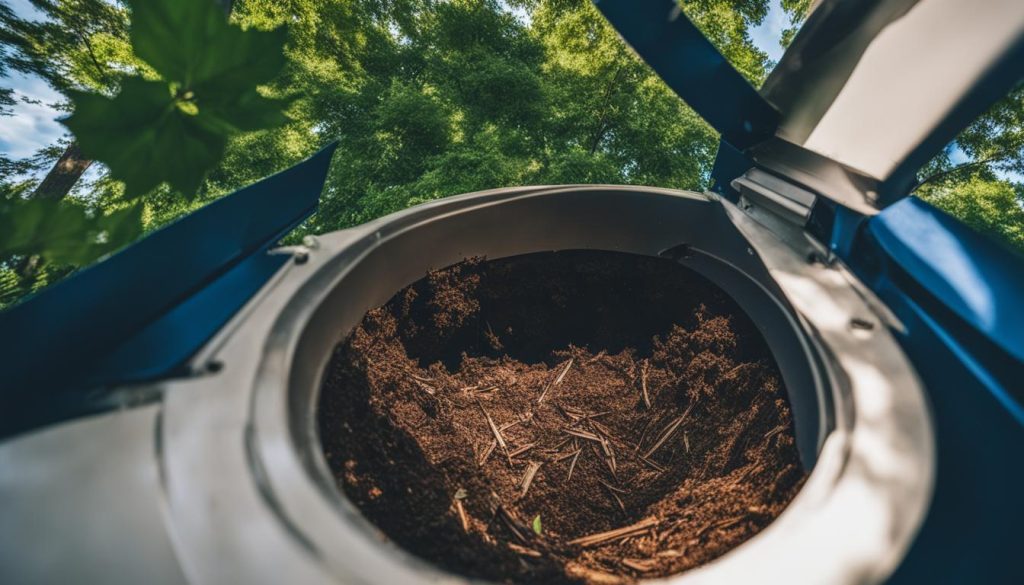
Why Choose Composting Toilets
Composting toilets offer an effective and environmentally friendly solution for pet waste disposal while hiking. By using these facilities, you ensure that the waste is properly managed and treated in a way that minimizes harm to the environment.
Composting toilets utilize a natural process to break down waste, turning it into nutrient-rich compost. This helps prevent contamination of water sources and reduces the spread of diseases. Additionally, it promotes responsible pet ownership and ensures that the trails remain clean and enjoyable for everyone.
| Benefits of Using Composting Toilets for Pet Waste Disposal | Considerations for Using Composting Toilets |
|---|---|
|
|
Bury It
In areas where burying human waste is recommended and permissible, burying your dog’s waste can be an acceptable disposal method. Use a trowel to dig a cathole at least six to eight inches deep and four to six inches wide. Place the poop inside the hole and cover it well. Ensure the cathole is at least 200 feet away from water sources and trails. However, do not bury the plastic dog poop bags, as they do not decompose.
Burying dog poop while hiking is a responsible and eco-friendly method of waste disposal. By burying the waste, you help prevent the spread of diseases and minimize the environmental impact. You might want to follow the proper guidelines for burying dog poop to ensure the integrity of the trails and the safety of other hikers.
To put it simply, dog waste does not decompose as quickly as human waste, so it is essential to dig the cathole deep enough. This will allow for adequate decomposition and minimize the risk of contamination. Always prioritize responsible pet ownership and adhere to the principles of leave no trace hiking.
Key Points:
- Burying dog poop is an acceptable method of disposal in areas where burying human waste is recommended.
- Use a trowel to dig a cathole at least six to eight inches deep and four to six inches wide.
- Place the poop in the hole and cover it well, ensuring the cathole is at least 200 feet away from water sources and trails.
- Do not bury plastic dog poop bags, as they do not decompose.
- Always practice responsible pet ownership and follow leave no trace principles.

| Disposal Method | Advantages | Disadvantages |
|---|---|---|
| Burying It | – Minimizes environmental impact – Prevents the spread of diseases – Easy to execute |
– Requires a trowel for digging – Dog waste takes longer to decompose – Plastic bags cannot be buried |
| Stink-Free Containers | – Minimizes odor and mess – Convenient for day hikes – Can be attached to backpack or leash |
– Containers need to be emptied – May not be suitable for longer trips |
| Make Your Dog Carry It | – Keeps your hands free – Reduces the burden on you – Suitable for dogs wearing a pack |
– Requires training – Limited capacity based on dog’s weight |
Eco-Friendly Dog Poop Disposal with Biodegradable Bags
As responsible pet owners, it is advisable for us to consider eco-friendly options for dog waste disposal while hiking. One effective solution is to use biodegradable dog poop bags, which are designed to break down naturally over time, minimizing their impact on the environment. These bags are typically made from materials like cornstarch or plant-based plastics, ensuring that they decompose more quickly than traditional plastic bags.
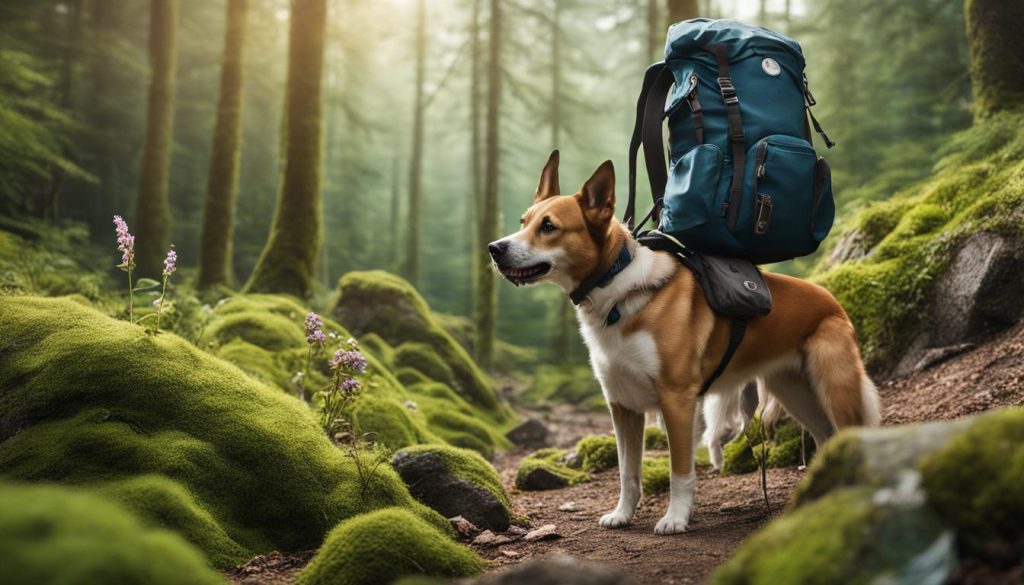
By choosing biodegradable bags, we can reduce the amount of plastic waste that ends up in landfills or pollutes our oceans. I suggest, however, to ensure that the bags meet ASTM International standards for biodegradability to ensure their effectiveness. When purchasing biodegradable bags, look for certifications or labels that indicate they meet these standards.
Using biodegradable bags not only helps to protect the environment but also promotes responsible pet ownership. By properly disposing of dog waste, we can prevent the spread of diseases, maintain clean and healthy trails, and show respect for other hikers and wildlife. You might want to always carry biodegradable bags with us while hiking and to dispose of them in designated receptacles or composting toilets, following local regulations and guidelines for waste management.
Reusing Plastic Bags or Newspapers
When it comes to responsible pet ownership and eco-friendly dog poop disposal, reusing plastic bags or newspapers can be a practical solution. If you live in an apartment or don’t have access to biodegradable bags, repurposing plastic bags from newspapers, grocery stores, or fruit purchases can help reduce waste. By giving these bags a second life, you contribute to minimizing environmental impact while still effectively disposing of dog waste.
To reuse plastic bags or newspapers for dog poop disposal, make sure to tightly secure the waste inside the bags to prevent odor and leakage. Double bagging can provide extra protection. Additionally, consider tying the bags securely to contain any potential mess. When disposing of the bags, find designated trash receptacles to ensure proper waste management. Avoid littering or leaving the bags on the trail, as this can harm the environment and create an unpleasant experience for other hikers.
If your municipality allows it, flushing the dog poop down the toilet can be another option for disposing of waste. However, it is good practice to check local regulations and use only biodegradable waste bags for flushing. Flushing dog waste directly without a bag is not recommended, as it can lead to plumbing issues and contaminate water sources. Always prioritize following the guidelines and regulations set by your local authorities for responsible pet waste disposal.
| Pros | Cons |
|---|---|
| Reduces waste by reusing existing materials | May not be suitable for all dog waste types or sizes |
| Cost-effective option | Requires proper disposal to prevent littering |
| Accessible for those without biodegradable bags | May not provide optimal odor control |
Innovative Poop Holders
When it comes to disposing of dog waste while hiking, there are several innovative poop holders available on the market that offer convenience and odor control. These poop holders are designed to securely hold filled dog waste bags, minimizing any potential smell and making it easier to carry the waste until you find a proper disposal receptacle. Here are some popular options:
Turdle Bag
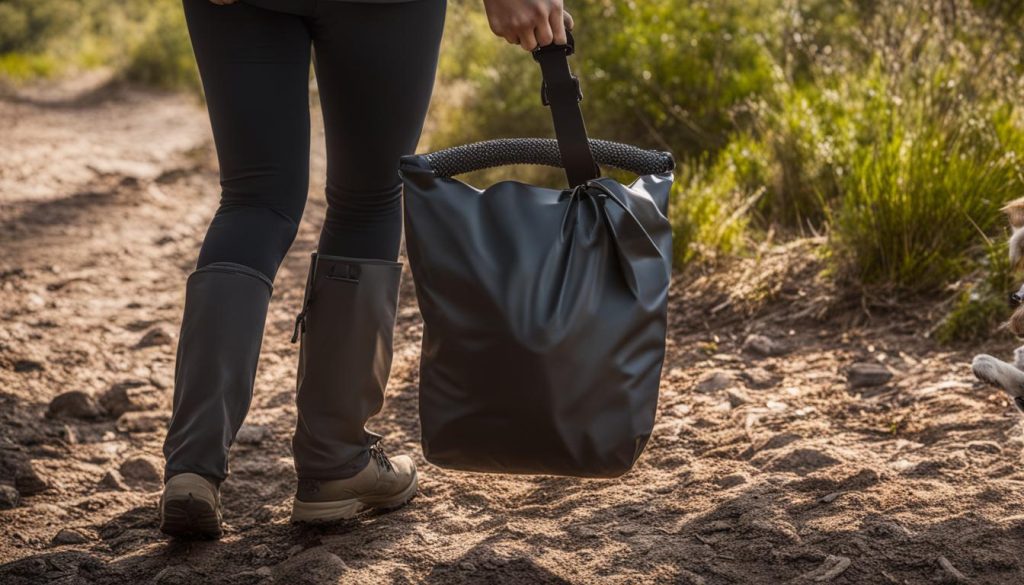
The Turdle Bag is a compact and discreet poop holder that attaches to your leash or backpack. It is designed to be odor-blocking, leak-resistant, and easy to use. With its innovative design, the Turdle Bag ensures that you won’t have to worry about any unpleasant odors or accidental leaks while hiking with your dog.
Civic Doody
The Civic Doody is another popular poop holder that offers both style and functionality. It has a sleek and modern design and can be easily attached to your belt or leash. The Civic Doody features a unique odor-blocking system that traps and neutralizes any smells, making it a great option for dog owners who want a discreet and odor-free way to carry their dog’s waste.
PoopPac
The PoopPac is a versatile poop holder that comes with multiple attachment options, including a belt clip and a carabiner clip. It is designed to be waterproof, odor-resistant, and easy to clean. The PoopPac also has additional compartments to hold other essentials like keys, phone, or treats, making it a convenient all-in-one solution for hiking with your dog.
Ruffwear Pack Out Bag
The Ruffwear Pack Out Bag is a rugged and durable poop holder that is designed to withstand outdoor adventures. It features a magnetic closure system that keeps the bag securely closed and helps contain any odors. The Pack Out Bag also has a built-in dispenser for quick and easy access to waste bags, making it a convenient option for hikers with active dogs.
Doo Doo Tube
The Doo Doo Tube is a compact and lightweight poop holder that is perfect for minimalist hikers. It easily attaches to your backpack or belt and ensures that you can carry your dog’s waste discreetly and without any unpleasant smells. The Doo Doo Tube is made from eco-friendly materials and is designed to be waterproof and odor-resistant.
These innovative poop holders provide dog owners with convenient and odor-free solutions for carrying their dog’s waste while hiking. Whether you prefer a compact and discreet option or a versatile and rugged design, there is a poop holder available to suit your needs. By using one of these innovative poop holders, you can ensure a clean and responsible hiking experience with your furry friend.
Responsible Hiking with Dogs
As responsible pet owners, it is our duty to clean up after our dogs while hiking to ensure a safe and pleasant experience for everyone. Proper dog waste disposal is essential not only for the preservation of the environment but also for maintaining the integrity of the trails we enjoy. By following some simple guidelines, we can minimize our impact and promote responsible hiking with dogs.
One of the most important things to remember is to always carry dog waste bags with you. These bags provide a convenient and hygienic way to pick up your dog’s waste. After bagging the waste, make sure to properly dispose of it in designated receptacles. Avoid leaving bagged waste on the trail or hanging it from trees, as this not only poses a hazard to wildlife but also creates an unsightly mess for other hikers.
If you are hiking in an area with composting toilets, you can dispose of your dog’s waste in these facilities. However, it is essential to bag the waste before depositing it in the designated receptacle. This helps contain the odor and prevents contamination of the composting process. Try to encourage your dog to defecate before reaching the composting toilet to ensure proper waste management.
Table: Comparison of Dog Waste Disposal Methods
| Disposal Method | Pros | Cons |
|---|---|---|
| Using stink-free containers | – Minimizes odor – Convenient for day hikes – Attaches to backpack or leash |
– Requires carrying an additional container – Limited capacity |
| Having your dog carry it | – Keeps hands free – Reduces burden on the hiker |
– Limited to dogs accustomed to wearing a backpack – Requires proper training |
| Disposing in composting toilets | – Proper waste management – Reduces environmental impact |
– Limited availability of composting toilets – Requires bagging waste beforehand |
| Burying it | – Allows for natural decomposition – Follows leave no trace principles |
– Requires digging catholes at least 200 feet away from trails and water sources – Plastic bags should not be buried |
To put it simply, responsible hiking with dogs is more than just cleaning up after them. It also involves respecting wildlife, other hikers, and the natural environment. Always keep your dog on a leash where required and ensure their behavior is under control. Be mindful of trail etiquette and yield to other hikers when necessary. By following these guidelines, we can enjoy the outdoors with our furry companions while minimizing our impact on the environment.
Final Thoughts
To sum it up, responsible disposal of dog poop while hiking is an essential aspect of responsible pet ownership and leave no trace hiking. By adopting effective waste management practices, such as using stink-free containers, having your dog carry their waste, or burying it properly, we can minimize our impact on the trails and maintain a healthy ecosystem.
It is our responsibility as dog owners to ensure that we leave no trace and leave the trails as clean as we found them. By following these practices, we can preserve the natural environment, prevent the spread of diseases, and promote responsible pet ownership.
Try to always carry dog waste bags, dispose of them in designated receptacles or composting toilets, and follow local regulations and guidelines for waste management. Together, let’s uphold our commitment to responsible pet ownership and leave no trace hiking for future generations to enjoy.
FAQ
Why is it important to responsibly dispose of dog poop while hiking?
Responsibly disposing of dog poop while hiking is important to maintain a clean and healthy environment for all trail users. Leaving dog waste on the trail can lead to environmental damage and create a negative reputation for dog owners.
What are the consequences of improper disposal of dog poop while hiking?
Improper disposal of dog poop while hiking can lead to the spread of diseases, contamination of soil and water sources, and disruption of the natural ecosystem. It can also contribute to issues like algae blooms in lakes and rivers.
How can I dispose of dog poop while hiking using a stink-free container?
You can use products like the PooVault or Turdlebag, which provide secure containers that can be attached to your backpack or leash. These containers are designed to hold bagged poop and minimize odor.
Can my dog carry their own waste while hiking?
Yes, if your dog wears a pack while hiking, you can train them to carry their own waste. This reduces the burden on you and keeps your hands free. Make sure to double bag the waste for hygiene purposes.
Can I dispose of dog poop in composting toilets on hiking routes?
Yes, in areas where composting toilets are available, you can dispose of your dog’s waste in these facilities. Bag the waste, twist the top to contain the odor, and deposit it in the designated receptacle.
How can I bury my dog’s waste while hiking?
Use a trowel to dig a cathole at least six to eight inches deep and four to six inches wide. Place the poop inside the hole and cover it well. Ensure the cathole is at least 200 feet away from water sources and trails.
Can I use biodegradable dog poop bags for disposal?
Yes, using biodegradable dog poop bags is an environmentally friendly option for disposal. However, most landfill conditions prevent organic material from decomposing properly, so be aware of the leftover feces polluting water sources.
Can I reuse plastic bags for dog poop disposal?
Yes, you can reuse plastic bags from newspapers, grocery stores, or fruit purchases as an alternative to buying new bags. Tightly secure the waste inside the bags to prevent odor and leakage.
Are there any innovative poop holders available for dog waste disposal?
Yes, there are several innovative poop holders available on the market, such as the Turdle Bag, Civic Doody, PoopPac, Ruffwear Pack Out Bag, and Doo Doo Tube. These holders are designed to disguise the smell and securely hold filled dog waste bags.
Why is responsible hiking with dogs important for pet owners?
Responsible hiking with dogs is important to promote responsible pet ownership, maintain cleanliness and beauty of the trails, prevent the spread of diseases, and ensure the well-being of wildlife and other hikers.






